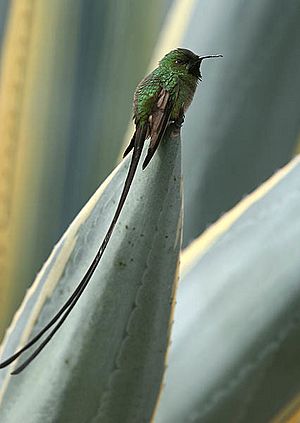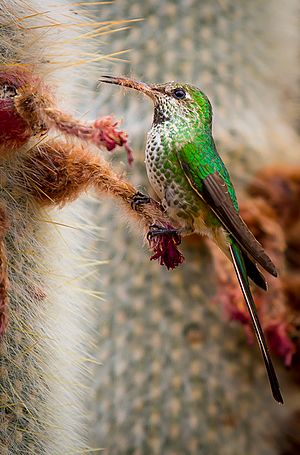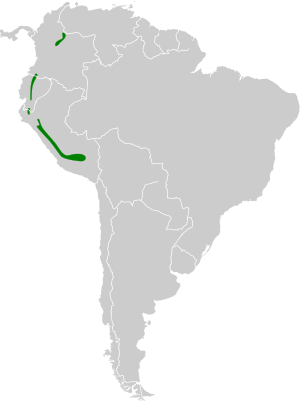Black-tailed trainbearer facts for kids
Quick facts for kids Black-tailed trainbearer |
|
|---|---|
 |
|
| Male in NW Ecuador | |
 |
|
| Female in southern Peru | |
| Conservation status | |
| Scientific classification | |
| Genus: |
Lesbia
|
| Species: |
victoriae
|
 |
|
| Range of Lesbia victoriae | |
The black-tailed trainbearer (scientific name: Lesbia victoriae) is a beautiful type of hummingbird. You can find these birds in the mountains of Colombia, Ecuador, and Peru. They live in places that are 2,500 to 3,800 meters (about 8,200 to 12,500 feet) high. These hummingbirds enjoy living in moist mountain forests, high-altitude shrublands, and even areas where forests have been cut down.
Contents
What Does the Black-tailed Trainbearer Look Like?
Male black-tailed trainbearers are quite long, measuring about 21 to 24 centimeters (8 to 9.5 inches). This length includes their very long, black tail feathers. Their bodies are mostly green, and they have a shiny, iridescent green patch on their chest and throat.
Female black-tailed trainbearers are smaller. They are about 13.5 to 14.5 centimeters (5 to 5.5 inches) long. Females have shorter tails than males. Their undersides are white with green spots.
This hummingbird has a bill that is longer and more curved downwards. The male's tail is also longer and more curved compared to a similar bird, the green-tailed trainbearer. Black-tailed trainbearers also tend to be a duller green color overall.
The largest type of black-tailed trainbearer is called Lesbia victoriae victoriae. Its wings are about 59.9 millimeters (2.3 inches) long.
Where Do Black-tailed Trainbearers Live?
The black-tailed trainbearer lives across the central and northern Andes mountains. Their home range stretches from Colombia, through Ecuador, and into Peru. They prefer altitudes between 2,500 and 3,800 meters (8,200 to 12,500 feet).
These hummingbirds like areas that are partly open, not dense, closed forests. This means they can live well in places like city parks and gardens.
Types of Black-tailed Trainbearers
Scientists recognize three main types, or subspecies, of the black-tailed trainbearer:
- Lesbia victoriae victoriae: This type lives in the northern parts of their range, from central Colombia to southern Ecuador.
- Lesbia victoriae juliae: You can find this type in the middle of their range, from southern Ecuador to northern Peru.
- Lesbia victoriae berlepschi: This is the southernmost type, living in Peru from Huánuco to Cuzco.
How Do Black-tailed Trainbearers Behave?
Black-tailed trainbearers are not very aggressive birds. Other, more aggressive hummingbirds, like the sparkling violetear, often chase them away from food sources.
What Do They Eat?
Black-tailed trainbearers are not picky eaters when it comes to nectar. They feed on flowers of many different sizes and types. They usually look for flowers close to the ground. Besides nectar, they also eat small insects and other tiny creatures. They tend to eat more insects than hummingbirds that live in lower areas.
How Do They Reproduce?
When a male black-tailed trainbearer wants to attract a female, he flies high into the air. He shows off his long tail, then dives down. As he dives, he makes a clicking sound with his tail feathers.
After the male and female mate, they work together to build a nest. They usually build their nest in a bush. Sometimes, they even use synthetic fibers, like bits of plastic or string, that humans have left behind. Both parents help take care of the nest. However, they tend to hide if they sense danger nearby.
Are Black-tailed Trainbearers Endangered?
The black-tailed trainbearer is doing quite well. The International Union for Conservation of Nature (IUCN) has listed them as a species of "least concern." This means they are not currently at risk of becoming endangered.
They are found over a wide area, and their populations are stable. Because they prefer open habitats, these hummingbirds can adapt well to changes in both city and country areas.


